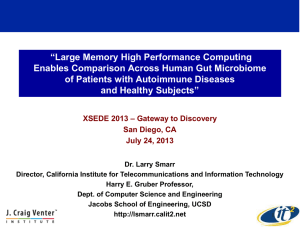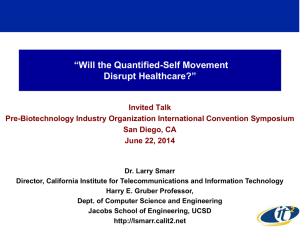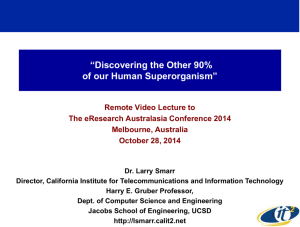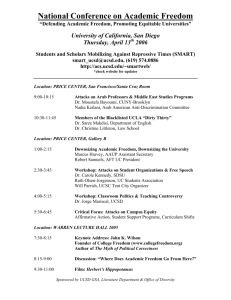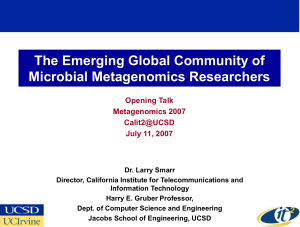Slides - Cenic
advertisement
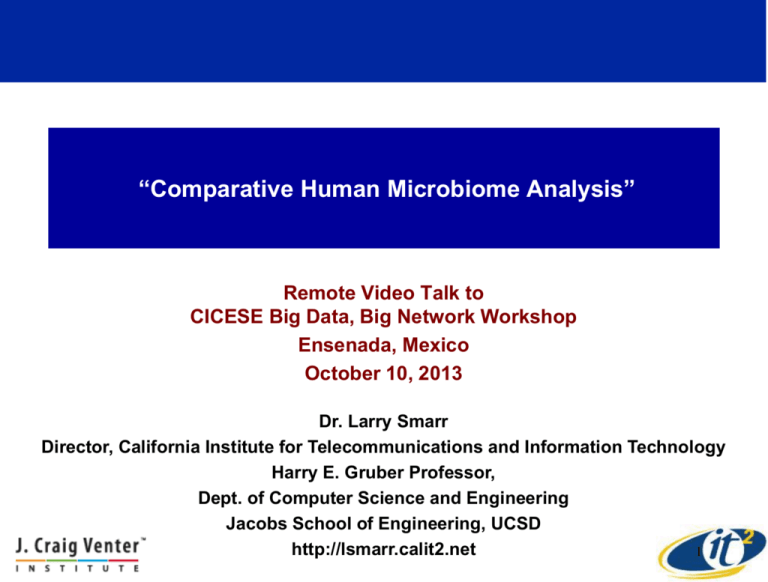
“Comparative Human Microbiome Analysis” Remote Video Talk to CICESE Big Data, Big Network Workshop Ensenada, Mexico October 10, 2013 Dr. Larry Smarr Director, California Institute for Telecommunications and Information Technology Harry E. Gruber Professor, Dept. of Computer Science and Engineering Jacobs School of Engineering, UCSD http://lsmarr.calit2.net 1 Abstract We are carrying out very deep metagenomic sequencing of human gut microbiomes from healthy subjects and from people with the autoimmune Inflammatory Bowel Disease. We compare one subject with IBD to metagenomic datasets downloaded from the NIH Human Microbiome Project repository, including 35 healthy subjects and 20 with IBD. We also analyze the changes in this one subject over multiple times, including comparing before and after drug therapy. The dataset of Illumina short reads for one person is ~10GB. The total comparison dataset contains ~0.5 trillion DNA bases. These Big Data had to be moved across the network to the San Diego Supercomputer Center where over 200,000 cpu-hours were consumed in the analysis and then back to Calit2 where a 64 megapixel wall was used for visual analysis. This approach could be extended for cross-border comparisons of human gut microbiomes to examine differences in food intake and various disease states. Larry Smarr is the Harry E. Gruber Professor in the Department of Computer Science and Engineering of the Jacobs School of Engineering at UC San Diego. He was the founding director of the California Institute for Telecommunications and Information Technology in 2000 and of the National Center for Supercomputing Applications in 1985. Weizhong Li currently leads a group of researchers funded by NIH and NSF at the Center for Research in Biological System in UC San Diego. He has more than 20 years of experience in bioinformatics, computational biology, and computational chemistry. Your Body Has 10 Times As Many Microbe Cells As Human Cells 99% of Your DNA Genes Are in Microbe Cells Not Human Cells Inclusion of the Microbiome Will Radically Change Medicine Gut Microbiome Metagenomic Datasets Comparing Healthy and Diseased States One “Read” = 100 DNA Bases Total of 12.5 Billion Reads! Source: Weizhong Li, CRBS, UCSD We Created a Reference Database Of Known Gut Genomes • NCBI April 2013 – – – – 2471 Complete + 5543 Draft Bacteria & Archaea Genomes 2399 Complete Virus Genomes 26 Complete Fungi Genomes 309 HMP Eukaryote Reference Genomes • Total 10,741 genomes, ~30 GB of sequences Now to Align Our 12.5 Billion Reads Against the Reference Database Source: Weizhong Li, Sitao Wu, CRBS, UCSD Computational NextGen Sequencing Pipeline: From “Big Equations” to “Big Data” Computing PI: (Weizhong Li, CRBS, UCSD): NIH R01HG005978 (2010-2013, $1.1M) Creating a Big Data Freeway System: Coupling ‘Omics Data Generators with Supercomputers Using Optical Fiber with 1000x Shared Internet Speeds We Used SDSC’s Gordon Data-Intensive Supercomputer to Analyze a Wide Range of Gut Microbiomes • ~180,000 Core-Hrs on Gordon – KEGG function annotation: 90,000 hrs – Mapping: 36,000 hrs – Used 16 Cores/Node and up to 50 nodes – Duplicates removal: 18,000 hrs Enabled by a Grant of Time – Assembly: 18,000 hrs on Gordon from SDSC – Other: 18,000 hrs Director Mike Norman • Gordon RAM Required – 64GB RAM for Reference DB – 192GB RAM for Assembly • Gordon Disk Required – Ultra-Fast Disk Holds Ref DB for All Nodes – 8TB for All Subjects Comparing 3 LS Time Snapshots (Left) with Healthy, Crohn’s, UC (Right Top to Bottom) Calit2 VROOM-FuturePatient Expedition Phyla Gut Microbial Abundance Without Viruses: LS, Crohn’s, UC, and Healthy Subjects Source: Weizhong Li, Sitao Wu, CRBS, UCSD LS Crohn’s Ulcerative Colitis Healthy Toward Noninvasive Microbial Ecology Diagnostics Lessons From Ecological Science: Invasive Species Dominate After Major Species Destroyed ”In many areas following these burns invasive species are able to establish themselves, crowding out native species.” Source: Ponderosa Pine Fire Ecology http://cpluhna.nau.edu/Biota/ponderosafire.htm Rare Firmicutes Bloom in Colon Disappearing After Antibiotic/Immunosuppressant Therapy Firmicutes Families Parvimonas spp. LS Time 1 Healthy Average LS Time 2 Thanks to Our Great Team! UCSD Metagenomics Team Weizhong Li Sitao Wu JCVI Team Karen Nelson Shibu Yooseph Manolito Torralba Calit2@UCSD Future Patient Team Jerry Sheehan Tom DeFanti Kevin Patrick Jurgen Schulze Andrew Prudhomme Philip Weber Fred Raab Joe Keefe Ernesto Ramirez SDSC Team Michael Norman Mahidhar Tatineni Robert Sinkovits
